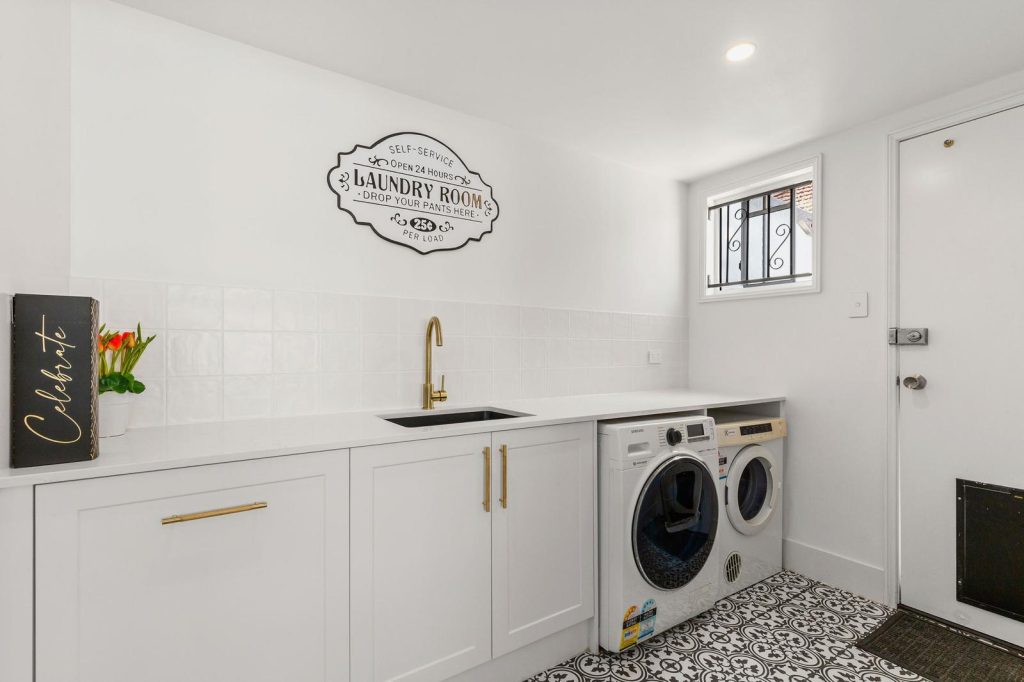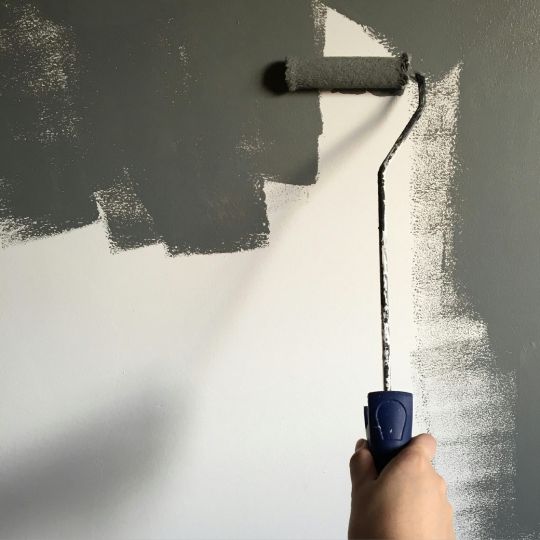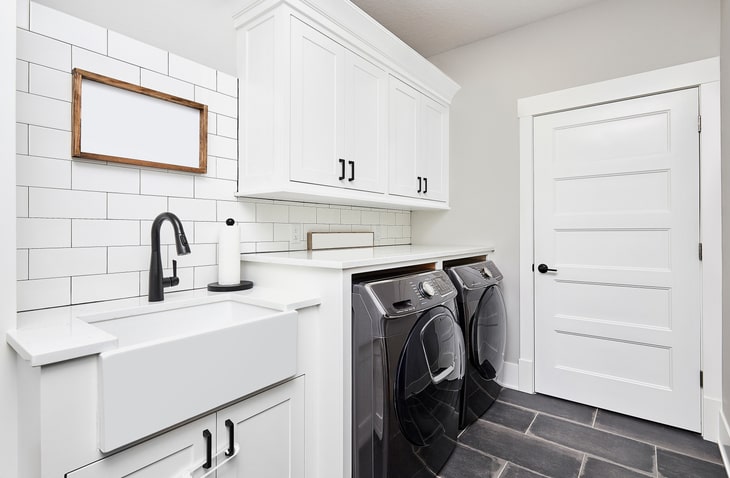This goes beyond simply replacing the washing machine and dryer. You need a plan for budgeting, materials, appliance updates, and a loose schedule to ensure your complete laundry remodel doesn’t end up over-capitalized.
We want to help you accurately plan you renovation whether it be a simple laundry remodel or the complete laundry of your dreams.
Benefits of a Laundry Room Remodel
A laundry room remodel is one of the best ways to increase your home’s value.
How to Plan a Laundry Room Remodel
Evaluate the Laundry Room for Areas of Improvement
You need to note things such as:
- Plumbing leaks
- Termite and other damage from pests
- Damaged or outdated appliances
- Lighting issues
- Drain problems
- Ceiling problems
- Dryer ventilation issues
- Electrical issues
- The presence of mold and mildew
- Flooring problems
- Discolored grout
- Laundry sink problems
- Accessibility & safety concerns
- Taking measurements of all dimensions
Research Options & Laundry Room Appliances
Determining Washer & Dryer Needs

The size of your family, and how often you need to do laundry will influence the size of the washer and dryer your new laundry room needs.
- A household of 1 to 2 people needs a washing machine with a capacity of 113 to 127 liters and a dryer capacity of 170 to 226 liters.
- A household of 3 to 4 people needs a washing machine with a capacity of 127 to 156 liters and a dryer capacity of 226 to 255 liters.
- A large household of 5 or more people will need a washing machine with a capacity of 156 liters or more and a dryer that’s at least 255 liters.
Take your time exploring hardware stores like Home Depot, Bunnings and other home improvement showrooms. Have a lazy weekend on the couch and watch home improvement show such as Three Birds Renovations, Fixer Upper, The Block, and Dream Home.
Compare the sizes of the washing machines and dryers you find and write down their precise external dimensions. Also, write down things like the length of the washing machine’s drain hose the size of the dryer’s vent hose, and how far the doors swing open.
Do this with other accessories you might want to incorporate into your laundry room remodel. This might include things like:
- Cabinets
- Cupboards
- Shelving
- Cubbies
- Ironing board (Collapsed and Expanded)
- Pull out laundry hampers
- Wash basins
Planning the Layout and Accessories
Once you have the external dimensions of key appliances and accessories you can start mocking up your laundry room remodel. I find it best to do this with graph paper and the following techniques.
Step One: Draw the room on a sheet of graph paper noting where all the waterlines, vents, drains, and electrical components are.
Step Two: Use a separate sheet of graph paper to cut out appliances and major accessories like cabinets and laundry hampers to scale. I like to use paint swatch cards because they bright and free!
Step Three: Move the cut-out pieces around on the first piece of graph paper, experimenting with different layouts.
Step Four: When you find a layout or two that you like, stick everything down.
Step Five: Go into the laundry room with a tape measure and get a feel for the distances between things in real space.
Measure the distances between things and ask some basic questions like.
- Can I reach from the washing machine from the hamper?
- Can the washer and dryer door swing freely without anything in the way?
- Will the ironing board get in the way of the dryer?
- Is the electrical outlet from the dryer too close to the waterlines of the wash basin?
When you’re playing with the layout, you might have a little wriggle room for moving the washing machine. This will be based on the length of the drain hose that you recorded during your appliance investigation.
However, dryers are relatively locked into the location of their vent port. Ideally, the vent hose needs to go out the port as directly as possible, without any left or right-hand turns. These kinks in the line can trap lint over time leading to long-term fire risk.
You might also be able to work with other components for renovating laundry room cabinets or refreshing countertops with a coat of paint. Countertops might be brought back to life with a fresh layer of laminate. The water heater might be easily hidden with a decorative curtain.
If you plan to hire a builder, ask if they have any photo examples of past laundry room renovations. Some have home improvement design services that can mock up some digital options for you to consider.
Determine Your Budget
Setting up a thoughtful budget for your laundry room renovation project requires balancing the cost of appliances and materials with the money you have available. This might mean the money you have on hand or the money you can access by financing.
There’s a real risk of overcapitalizing the remodeling costs if you just start with your imagine your dream laundry room, and plan to blindly finance it. Consider asking yourself the following questions.
- Can I handle this laundry room remodel myself?
- How much do the major appliances cost?
- Can I repaint or laminate existing cabinets and counters?
- Do I have the skills to DIY the laundry room renovation?
- Should I hire a professional builder?
- How much will the builder cost?
- How much money do I have to spend on the laundry room remodel?
- Can I finance this home improvement project?
Objectively answering these questions will help you come up with a realistic laundry room renovation cost with the lowest risk of overcapitalization. Consider getting multiple quotes from builders to help you understand just how much labor costs can add to the project.
PRO TIP: Keep and eye out for second hand items in Facebook Marketplace and Gumtree. We have found for our own renovations many bargains online from people who have bought items new for their renovation that they were not able to use for whatever reason. Some items were still sealed in the box! We saved thousands of dollars just in taps.
Draw Up a Schedule
If you’re considering a DIY laundry room remodel, you also need to draw up a basic schedule. You should also expect the home improvement project to take longer than you expect.
There are almost always unforeseen things like delays in things like appliance delivery, permitting, and inspections. Don’t plan your completion date to be anywhere near other major plans like going on holiday or other special events. You don’t want to miss your sister’s wedding because you have to wait at home for the inspector to show up 3 days late.
Find the Right Builder
If you plan to have a professional builder do your laundry room remodel, you need to do your research. This includes contacting at least 3 licensed and insured builders to get quotes. Any specialists such as plumbers and electricians need to have the necessary qualifications that meet the state’s standards.
Request itemized quotes from each builder and compare each one line by line. Keep a sharp eye out for signs of inflated markup costs.
If one builder’s quote seems to be marking up the cost of materials or has a higher anticipated labor time than the other it’s a bit of a red flag. This is often a sign that the builder could mark up other things. They’re more likely to go grossly over budget on labor and additional hidden fees, leaving you with an over-capitalized laundry room renovation.
One easy way to save money is to have a professional builder handle the major things like electrical, plumbing, and appliance installation. Then you handle the cosmetic components like trim, painting and décor. This can save you 20% or more on the renovation cost to reduce your risk of over-capitalization.
PRO TIP: Investigate each builder and tradesperson online for reviews from past clients. Check their credentials and history with your local building and construction authority to confirm their licenses are current and valid for the work you are engaging them for.
Permits and Certification
If you’re making any changes to the structure of the room, or changing the plumbing or electrical work, your laundry room remodel might require special permits or certification. The state or local council might require a pre-inspection and completed inspection. If you’re working with a professional builder, they’ll take care of this for you.
If you apply for the permit yourself, you’ll need to include a rough schedule estimate. Be sure to give yourself at least an extra week of leeway before the final inspection.
Demolition & Site Prep
Laundry room demolition needs to be a precise process of carefully removing old appliances and components. Being detail-oriented helps prevent costly mistakes and wasted time.
You need to consider.
- Where you’ll do laundry during the home improvement.
- How to turn the water off to all the fixtures in the laundry room.
- How to safely shut off all electrical and gas lines.
- How to properly remove appliances and major components.
- Does the property required licensed removal of asbestos?
- How to dispose of demolished materials?
- What materials can be recycled or repurposed?
Performing the Renovation

With a DIY laundry room renovation, you need to have a plan for how you’re bringing things in and installing them. You need a plan to “Start Far and Finish Near” while also making sure that the dryer and washing machine are being installed in a way that doesn’t interfere with how other components go in.
This can be trickier than it sounds on screen. If you’re having the appliances delivered, the company will usually handle the installation. However, they want to do both appliances at the same time, and they won’t install one and come back later to install the other without a big fee.
So, if you need the dryer to go in, then something like a cabinet goes in next to it, before the washing machine goes in, you’ll have to have a plan to do that quickly. If there’s no way to do this, and you need to have the delivery people install something, the wise move is to have them install the dryer.
Vented clothes dryers have more complicated requirements than washing machines. Electrical lines and vent components need to be installed according to building codes. Gas lines need to be minded and the dryer needs to sit firmly so it doesn’t vibrate.
A washing machine is much simpler. Flexible water lines need to be run to it, and the drain line connects to the laundry room drainpipe in seconds. All of which you should be able to handle yourself with the help of a strong-backed friend.
If you’re having a professional builder handle your laundry room remodel, this is a non-factor. They’ll take care of all the installation details without any headaches for you.
Scheduling an Inspection
If the local building codes or insurance policy requires a laundry room remodel inspection, you’ll need to schedule it yourself. If you’re using a professional builder, they’ll handle this for you.
A simple home improvement inspection typically costs between $200 to $500.
If an inspector shows up at a pre-scheduled time, and the laundry room renovation isn’t done, they’ll still likely charge you for their time. Then they’ll charge you again when they return for the final inspection. This is why you need to give yourself extra leeway when coming up with a home improvement schedule.
Wrapping It Up
When planning a laundry room renovation, you need to keep a sharp eye on the costs for major components like a new washer and dryer. You also have to account for the location of the hookups, the size of each appliance, and the swing radius of the doors.
If you need to make major changes to the plumbing, electrical or other hookups in your laundry room remodel, you should contact a professional builder. Be sure to get multiple quotes and then compare them line by line. Make sure the builder you hire has a reputation for getting the job done reasonably close to the original budget.

